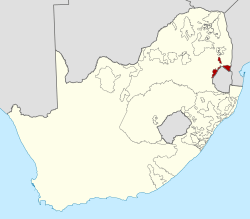KaNgwane
| KaNgwane | ||||||||||
| Bantustan | ||||||||||
| ||||||||||
| ||||||||||
 Location of KaNgwane (red) within South Africa (yellow). | ||||||||||
| Capital | KaNyamasane (Louieville) Schoemansdal (de facto) | |||||||||
| Languages | Swati | |||||||||
| Political structure | Bantustan | |||||||||
| History | ||||||||||
| • | Self-government | 1981 | ||||||||
| • | Re-integrated into South Africa | 27 April 1994 | ||||||||
| Area | ||||||||||
| • | 1980[1] | 3,000 km² (1,158 sq mi) | ||||||||
| Population | ||||||||||
| • | 1980[1] est. | 161,160 | ||||||||
| Density | 53.7 /km² (139.1 /sq mi) | |||||||||
| • | 1991[2] est. | 779,240 | ||||||||
| Currency | South African rand | |||||||||
| ||||||||||
KaNgwane was a bantustan in South Africa, intended by the apartheid government to be a semi-independent homeland for the Swazi people. It was called the "Swazi Territory" before it was granted nominal self-rule in 1981. Its capital was at Louieville (formerly KaNyamasane). It was the least populous of the ten homelands, with an estimated 183,000 inhabitants.
An attempt to transfer parts of the homeland, along with parts of the Zulu homeland KwaZulu, to the neighbouring country of Swaziland in 1982 failed following protests. The homeland's territory had been claimed by King Sobhuza of Swaziland as part of the Swazi monarchs' traditional realm, and the South African government hoped to use the homeland as a buffer zone against guerrilla infiltration from Mozambique. This would have given land-locked Swaziland access to the sea. South Africa responded to the failure of the transfer by temporarily suspending the autonomy of KaNgwane, then restoring it in 1984.[3][4]
Unlike the other homelands in South Africa, KaNgwane did not adopt a distinctive flag of its own but flew the national flag of South Africa.
KaNgwane ceased to exist on 27 April 1994 when the Interim Constitution dissolved the homelands and created new provinces. Its territory became part of the province of Mpumalanga.
Districts in 1991
Districts of the province and population at the 1991 census.[2]
- Eerstehoek: 192,115
- Nkomazi: 276,965
- Nsikazi: 310,160
See also
References
- 1 2 Sally Frankental; Owen Sichone (2005-01-01). South Africa's Diverse Peoples: A Reference Sourcebook. ABC-CLIO. p. 187. ISBN 978-1-57607-674-3. Retrieved 2013-09-18.
- 1 2 "Census > 1991 > RSA > Variable Description > Person file > District code". Statistics South Africa - Nesstar WebView. Retrieved 18 August 2013.
- ↑ Dennis Austin. South Africa, 1984. London: Routledge & Kegan Paul Ltd. 1985. p. 54.
- ↑ Leroy Vail. The Creation of Tribalism in Southern Africa. California: University of California Press. 1989. pp. 310-316.
Bibliography
- „Informa” April 1981 vol XXVIII No 3 (The Department of Foreign Affairs and Information of RSA, newspaper)
.svg.png)
